D-Series (Ceramic)
Diesel Oxidation Catalysts (DOC) Features
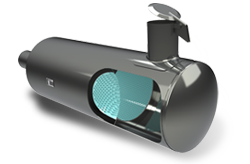
- Ceramic DOC technology with Zeolites designed to extend the performance of diesel catalytic converters into the low-temperature range
- D-Series DOC is ideal for Off-road application (construction, mining, material handling, utility), On-road, Power Generation, Marine, Gantry Cranes and Locomotive industries
- Maintenance-free, reliable and cost-effective emission control solution
- Available in both universal and direct-fit designs (Nett Technologies has a database of over 10000 direct-fit muffler designs)
- Mufflers are built entirely from corrosion resistant materials: aluminized and stainless steels
- Installation time and cost are reduced to a minimum
- DOC Catalytic Mufflers match or surpass the original muffler in sound attenuation and back pressure characteristics with the addition of superior emissions performance
- Great at reducing deadly emissions, such as Carbon Monoxide (CO) and Hydrocarbons (HC)
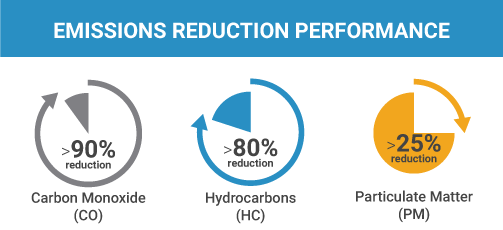
D-Series - Technology
The D-Series Diesel Oxidation Catalysts (DOC) are available on ceramic substrates. Round cordierite substrates with square cell geometry are used in all D-Series catalysts. Selected properties of the substrates are listed in Table 1 below.
Catalyzed substrates are wrapped in special packaging mat and packed into a steel container using the tourniquet packaging technology. Tourniquet is known as the best catalytic converter packaging technology, producing the most rugged and durable converters.
Ceramic substrates produce somewhat higher pressure drop than metallic substrates of the same dimensions, due to their thicker walls. However, for most applications the D-Series catalysts are sized larger than M-Series Diesel Oxidation Catalysts (DOC) are, in order to provide sufficient volume of the HC trap. By using D-Series catalyst substrates of larger diameter and larger frontal area, it is possible to achieve comparable pressure losses for the M-Series and D-Series catalysts when installed on identical engines.
Most pressure drop comparisons between the ceramic and metal catalyst supports are based on bare (uncoated) substrates. While the uncoated ceramic supports do have thicker walls (Table 1), the difference in wall thickness decreases after the catalyst coating is applied. This is explained by the inherent porosity of ceramic substrates, which "soak in" a portion of the catalyst coating into the wall pores. Since metallic substrates are not porous, the entire catalyst coating stays at their surface. Therefore, when the same loading of catalyst material is applied to a ceramic and a metallic substrate, it produces a thicker coating layer and more flow restriction in the metallic support.
Table 1- Physical Properties of Nett Catalyst Monoliths (uncoated)
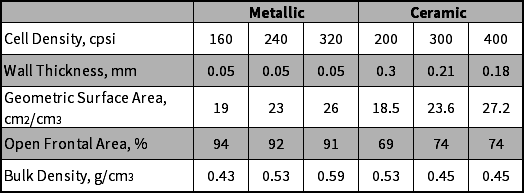
D-Series - Performance
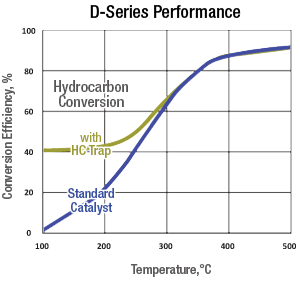 D-Series Diesel Oxidation Catalysts (DOC) include zeolite-based hydrocarbon traps for improved low temperature activity and diesel odor control. They are capable of 40-50% HC conversion and effective diesel odor control at very low exhaust temperatures.
D-Series Diesel Oxidation Catalysts (DOC) include zeolite-based hydrocarbon traps for improved low temperature activity and diesel odor control. They are capable of 40-50% HC conversion and effective diesel odor control at very low exhaust temperatures.
The exact emission performance depends on the catalyst size, exhaust temperature, and raw exhaust composition. A minimum temperature of about 180°C (360°F) is required for conversion. Best catalyst performance occurs at temperatures above 250-300°C (480-570°F) when the conversion of carbon monoxide exceeds 90%. Conversion of diesel particulate matter in the catalyst depends on the composition of the particulates and the sulfur content of the fuel. Achievable particulate matter reductions amount to 30-50%.
The D-Series Diesel Oxidation Catalysts (DOC) show a significantly improved hydrocarbon performance at low exhaust temperatures. An example performance chart is shown below. It is important to understand that the low temperature HC activity is due to the adsorption on the HC trapping material rather than due to catalytic oxidation. Since the adsorption capacity is always limited and the HC traps have to be periodically regenerated by higher exhaust temperatures, this type of catalyst system is effective only at transient engine operation. The amount of HC trapping material in the Nett® D-Series Diesel Oxidation Catalysts (DOC) catalysts is sufficient for a maximum of 15 - 30 minutes of continuous low temperature HC and odor control.
Catalyst Durability
The rugged construction of Nett Technologies' exhaust purifiers, using either metallic or ceramic supports, provides excellent mechanical durability. The catalyst substrate is designed to last for the entire life-span of the engine. Good engine maintenance, however, is necessary to sustain the catalyst activity for similar period of time. The two major causes of catalyst deactivation are (1) high temperature and (2) poisoning.
The Nett Technologies' catalyst may suffer thermal degradation when exposed to temperatures above 650°C (1200°F) for prolonged periods of time. Diesel engines have intrinsically cool exhaust gases and thermal catalyst deterioration is not likely to take place under normal operating conditions. Catalyst overheating may occur only as a result of serious engine malfunction, such as leaking injectors, when unburned fuel is oxidized in the catalyst and excessive temperature rise is observed due to the exothermic reaction.
Several chemical elements have the ability to either selectively poison the catalyst or to mask the catalytic surface, thus, preventing the contact between exhaust gases and active catalyst sites. Substances to be avoided include phosphorus, zinc, heavy metals, lead, arsenic, vanadium, and silicone. Some of these elements (e.g., phosphorus) may be contained as additives in the engine lube oil. Low lube oil consumption and the use of low-phosphorus oils are guidelines for extended catalyst life. Leaks of lube oil into the exhaust system are very detrimental and can irreversibly deactivate the catalyst within a few hours or days.
D-Series - Designs and Options
D-Series DOC are available in two designs: universal fit (clamped or welded) and direct-fir replacement (of the OEM muffler).
Direct-Fit Catalytic Mufflers
Nett Technologies has direct-fit catalytic mufflers available for thousands of models of construction equipment, forklift trucks and other diesel powered equipment. The pre-designed models are in-stock or can be built and shipped within a few days. Catalytic mufflers are available to replace the original muffler for any diesel application. The D-Series emission control catalyst is built into the muffler and is selected based on the size of the engine. Catalytic mufflers are guaranteed to be a exact-fit replacement for the original muffler. The emissions reduction performance of catalytic mufflers is also guaranteed, provided the engine is well maintained without excessive lube oil consuption.
Universal-Fit Catalytic Converters
 Nett Technologies offers two universal-fit configurations for the D-Series catalytic purifiers, as shown in images below. The welded (one-piece) design is more compact and recommended for space-limited applications. The clamped design allows for easy removal of the center-body (catalyst) for inspection and cleaning, if required.
Nett Technologies offers two universal-fit configurations for the D-Series catalytic purifiers, as shown in images below. The welded (one-piece) design is more compact and recommended for space-limited applications. The clamped design allows for easy removal of the center-body (catalyst) for inspection and cleaning, if required.
Dimensional Data for Nett D-Series Universal-Fit DOC's

Options
Add-on Mufflers
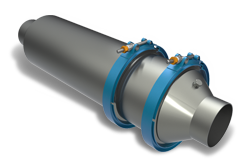
For universal-fit clamped converters, add-on mufflers are available which replace the outlet cone of the DOC. The add-on muffler adds sound reduction to the DOC for installations where the original muffler is being removed.
Insulative Blankets
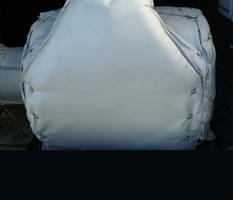
Custom heat-insulative blankets are available for applications where the additional heat generated by the DOC's catalytic activity is a concern for operators, others in the vicinity or the equipment itself. Blankets can be designed to cover the DOC, exhaust piping, mufflers or the entire exhaust system.
OEM Products
OEM applications are developed in co-operation with the equipment manufacturer. The catalyst specifications are optimized to meet the particular emission targets and durability requirements. As well, the design of the catalytic converter, including the catalyst substrate selection, canning technology, and noise attenuation requirements are optimized for the application. Development of OEM exhaust systems includes the design and fabrication of prototypes which are tested for emission and noise performance. Nett also provides compliance certification with the EPA or California ARB (Air Resources Board) regardless of whether a Nett emission control device is utilized. Three emission test cells are available for exhaust analysis of LPG, gasoline, CNG or diesel engines up to 250 kW (335 hp). See Engine Emissions Test Laboratory section for more information.
D-Series - Technology
The D-Series Diesel Oxidation Catalysts (DOC) are available on ceramic substrates. Round cordierite substrates with square cell geometry are used in all D-Series catalysts. Selected properties of the substrates are listed in Table 1 below.
Catalyzed substrates are wrapped in special packaging mat and packed into a steel container using the tourniquet packaging technology. Tourniquet is known as the best catalytic converter packaging technology, producing the most rugged and durable converters.
Ceramic substrates produce somewhat higher pressure drop than metallic substrates of the same dimensions, due to their thicker walls. However, for most applications the D-Series catalysts are sized larger than M-Series Diesel Oxidation Catalysts (DOC) are, in order to provide sufficient volume of the HC trap. By using D-Series catalyst substrates of larger diameter and larger frontal area, it is possible to achieve comparable pressure losses for the M-Series and D-Series catalysts when installed on identical engines.
Most pressure drop comparisons between the ceramic and metal catalyst supports are based on bare (uncoated) substrates. While the uncoated ceramic supports do have thicker walls (Table 1), the difference in wall thickness decreases after the catalyst coating is applied. This is explained by the inherent porosity of ceramic substrates, which "soak in" a portion of the catalyst coating into the wall pores. Since metallic substrates are not porous, the entire catalyst coating stays at their surface. Therefore, when the same loading of catalyst material is applied to a ceramic and a metallic substrate, it produces a thicker coating layer and more flow restriction in the metallic support.
Table 1- Physical Properties of Nett Catalyst Monoliths (uncoated)

D-Series - Performance
 D-Series Diesel Oxidation Catalysts (DOC) include zeolite-based hydrocarbon traps for improved low temperature activity and diesel odor control. They are capable of 40-50% HC conversion and effective diesel odor control at very low exhaust temperatures.
D-Series Diesel Oxidation Catalysts (DOC) include zeolite-based hydrocarbon traps for improved low temperature activity and diesel odor control. They are capable of 40-50% HC conversion and effective diesel odor control at very low exhaust temperatures.
The exact emission performance depends on the catalyst size, exhaust temperature, and raw exhaust composition. A minimum temperature of about 180°C (360°F) is required for conversion. Best catalyst performance occurs at temperatures above 250-300°C (480-570°F) when the conversion of carbon monoxide exceeds 90%. Conversion of diesel particulate matter in the catalyst depends on the composition of the particulates and the sulfur content of the fuel. Achievable particulate matter reductions amount to 30-50%.
The D-Series Diesel Oxidation Catalysts (DOC) show a significantly improved hydrocarbon performance at low exhaust temperatures. An example performance chart is shown below. It is important to understand that the low temperature HC activity is due to the adsorption on the HC trapping material rather than due to catalytic oxidation. Since the adsorption capacity is always limited and the HC traps have to be periodically regenerated by higher exhaust temperatures, this type of catalyst system is effective only at transient engine operation. The amount of HC trapping material in the Nett® D-Series Diesel Oxidation Catalysts (DOC) catalysts is sufficient for a maximum of 15 - 30 minutes of continuous low temperature HC and odor control.
Catalyst Durability
The rugged construction of Nett Technologies' exhaust purifiers, using either metallic or ceramic supports, provides excellent mechanical durability. The catalyst substrate is designed to last for the entire life-span of the engine. Good engine maintenance, however, is necessary to sustain the catalyst activity for similar period of time. The two major causes of catalyst deactivation are (1) high temperature and (2) poisoning.
The Nett Technologies' catalyst may suffer thermal degradation when exposed to temperatures above 650°C (1200°F) for prolonged periods of time. Diesel engines have intrinsically cool exhaust gases and thermal catalyst deterioration is not likely to take place under normal operating conditions. Catalyst overheating may occur only as a result of serious engine malfunction, such as leaking injectors, when unburned fuel is oxidized in the catalyst and excessive temperature rise is observed due to the exothermic reaction.
Several chemical elements have the ability to either selectively poison the catalyst or to mask the catalytic surface, thus, preventing the contact between exhaust gases and active catalyst sites. Substances to be avoided include phosphorus, zinc, heavy metals, lead, arsenic, vanadium, and silicone. Some of these elements (e.g., phosphorus) may be contained as additives in the engine lube oil. Low lube oil consumption and the use of low-phosphorus oils are guidelines for extended catalyst life. Leaks of lube oil into the exhaust system are very detrimental and can irreversibly deactivate the catalyst within a few hours or days.
D-Series - Designs and Options
D-Series DOC are available in two designs: universal fit (clamped or welded) and direct-fir replacement (of the OEM muffler).
Direct-Fit Catalytic Mufflers
Nett Technologies has direct-fit catalytic mufflers available for thousands of models of construction equipment, forklift trucks and other diesel powered equipment. The pre-designed models are in-stock or can be built and shipped within a few days. Catalytic mufflers are available to replace the original muffler for any diesel application. The D-Series emission control catalyst is built into the muffler and is selected based on the size of the engine. Catalytic mufflers are guaranteed to be a exact-fit replacement for the original muffler. The emissions reduction performance of catalytic mufflers is also guaranteed, provided the engine is well maintained without excessive lube oil consuption.
Universal-Fit Catalytic Converters
 Nett Technologies offers two universal-fit configurations for the D-Series catalytic purifiers, as shown in images below. The welded (one-piece) design is more compact and recommended for space-limited applications. The clamped design allows for easy removal of the center-body (catalyst) for inspection and cleaning, if required.
Nett Technologies offers two universal-fit configurations for the D-Series catalytic purifiers, as shown in images below. The welded (one-piece) design is more compact and recommended for space-limited applications. The clamped design allows for easy removal of the center-body (catalyst) for inspection and cleaning, if required.
Dimensional Data for Nett D-Series Universal-Fit DOC's

Options
Add-on Mufflers

For universal-fit clamped converters, add-on mufflers are available which replace the outlet cone of the DOC. The add-on muffler adds sound reduction to the DOC for installations where the original muffler is being removed.
Insulative Blankets

Custom heat-insulative blankets are available for applications where the additional heat generated by the DOC's catalytic activity is a concern for operators, others in the vicinity or the equipment itself. Blankets can be designed to cover the DOC, exhaust piping, mufflers or the entire exhaust system.
OEM Products
OEM applications are developed in co-operation with the equipment manufacturer. The catalyst specifications are optimized to meet the particular emission targets and durability requirements. As well, the design of the catalytic converter, including the catalyst substrate selection, canning technology, and noise attenuation requirements are optimized for the application. Development of OEM exhaust systems includes the design and fabrication of prototypes which are tested for emission and noise performance. Nett also provides compliance certification with the EPA or California ARB (Air Resources Board) regardless of whether a Nett emission control device is utilized. Three emission test cells are available for exhaust analysis of LPG, gasoline, CNG or diesel engines up to 250 kW (335 hp). See Engine Emissions Test Laboratory section for more information.
Photo Gallery


